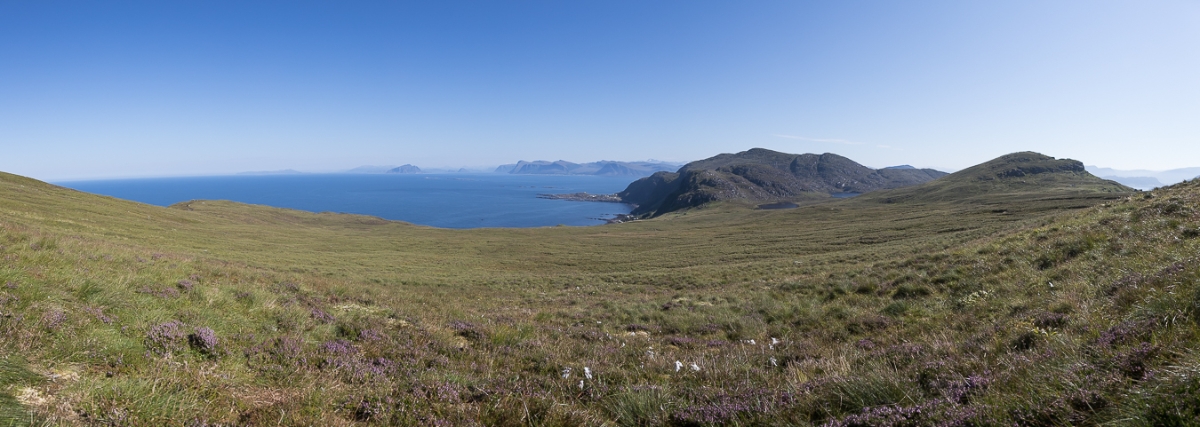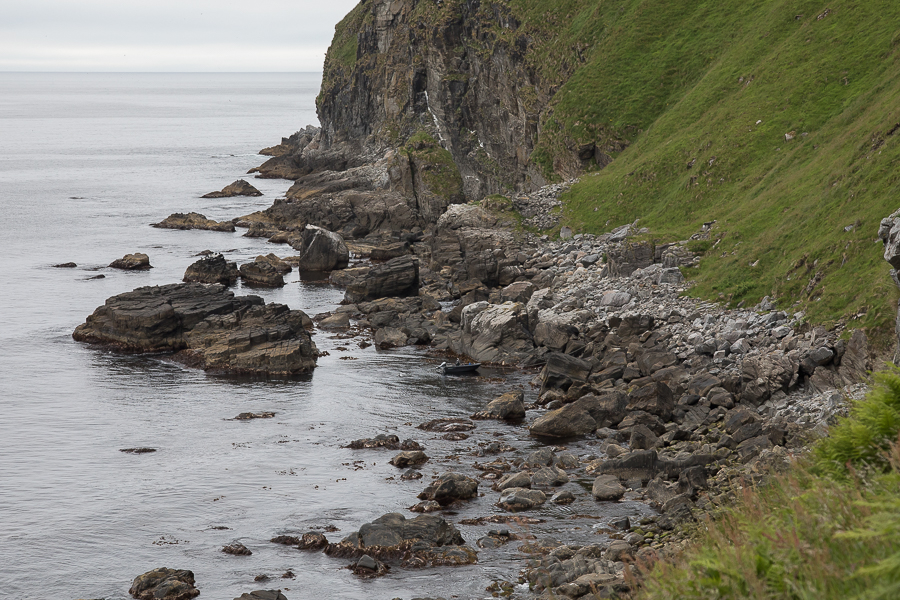Key site Runde
Runde, located at Sunnmøre in Møre og Romsdal, is Norway’s and Scandinavia’s southernmost large bird cliff. Seabirds have been monitored here since 1959. Atlantic puffin, common guillemot, razorbill, European shag, northern gannet and great skua breed at Runde. Runde was included as a SEAPOP key site in 2007, and included the kittiwake colony in Steinvågsundet on Aspøya in Ålesund in 2011. Contact person: Signe Christensen-Dalsgaard, NINA

Photo: Ingar Støyle Bringsvor
Location and description
Runde (62°24’N 05°37’E) is a 6.3 km2 island in Herøy municipality, in south Møre og Romsdal, just north of Stadt. Runde is a popular tourist destination. Each year, thousands of people visit the island with its steep grassy slopes and large cliffs to get a view of the magnificent “west coast nature”, and to see the thousands of seabirds breeding there. Puffins Fratercula arctica, razorbills Alca torda, common guillemots Uria aalge, northern gannets Morus bassanus, European shags Phalacrocorax aristotelis and kittiwakes Rissa tridactyla breeds on the west side of the island. On the NW end of the island is Runde lighthouse. Due to many shipwrecks in the area, a lighthouse was established in 1767. It was automated in 2002 and the lighthouse keepers’ house is now used as a tourist cabin. As of 1 Jan 2017, 117 people live on the island, which is connected to the mainland by a bridge and causeway that was opened in 1982. Today most of the land area on the island is protected as a nature reserve. The bird life at Runde was protected in 1957 on the initiative of the locals. In 1981, the conservation area was established comprising four bird areas on Runde and one surrounding Runde and Grasøyane. In 1996, Goksøyrmyrane also became a nature reserve. Access to the bird conservation areas is forbidden between 15 March and 31 August.
Access
To access the bird cliff on the southwest side of the island, you need to walk. You can leave your car at the carpark at Goksøyra and follow the marked path up to the plateau, through Goksøyrmyane and up to Lundeura. There is a rich network of marked paths on Runde. These lead you to lookout points where you can see most of the seabirds that breed on the island.
Wildlife
For centuries, large breeding populations of the most common seabird cliff species have bred at Runde with a maximum of approximately 250 000 pairs. These included 100 000 pairs of kittiwake, 100 000 pairs of puffin, 10 000 pairs of common guillemot, 3-4000 pairs of razorbill, 3-4000 pairs of fulmar and 5000 pairs of European shag. The seabirds at Runde have, however, been struggling, especially since the turn of the century and the populations have declined dramatically and, in some cases, disappeared. The last fledging fulmar chick was seen in 2001, and in 2005, the populations of razorbill, common guillemot and puffin started to collapse. Until then, the razorbill population had been stable. In “skarveura” northwest on the island, the European shag population was at a maximum in the 1980s with 5000 breeding pairs, making it the world’s largest colony. This colony was empty in 2014. Now you can find a few hundred pairs breeding on the west side of the island, but this is only a small fraction of what it was. The kittiwake population, which was spread around on the island, also reached zero in 2014. The populations of auks have also been declining until the beginning of the 2000s. Two species are increasing on Runde, the northern gannet and the great skua Stercorarius skua. Since its establishment in Rundebranden in 1946, the gannet colony has increased to become Norway’s largest. The great skua settled somewhat later on the island, with the first breeding pair in Goksøyrmyrane in 1980, since when it has been increasing steadily. In 2015, the breeding population of great skua on Runde was Norway’s largest, when one excludes Svalbard.sjåen in the west and Finnkonneset in the east.
Other seabird species breeding at Runde include the black guillemot Cepphus grylle, herring gull Larus argentatus, lesser black-backed gull L. fuscus, great black-backed gull L. marinus and common gull L. canus. On the islands Grasøya and Skjervøya, northeast of Runde, common eider Somateria mollissima, common tern Sterna hirundo and Arctic tern Sterna paradisaea breed. White-tailed eagles Haliaeetus albicilla also breed at Runde. In 2010, the first breeding pair for 80 years was observed on the island. In spring, when young eagles migrate northwards, and later in summer, when there are seabird carcasses lying around, many eagles soar above the island. It is usual to see about 5-10 individuals.
A lot of tourists, hikers and birdwatchers visit Runde. Hence the species list for the island is long including large numbers of both small and large birds that visit on migration.
Rodents are common on Runde, and include the brown rat Rattus norvegicus, house mouse Mus musculus, wood mouse Apodemus sylvaticus and shrews Soricidae spp. You can also find European hedgehog Erinaceus europaeus, otter Lutra lutra, American mink Neovison vison, stoat Mustela erminea, harbour seal Phoca vitulina, grey seal Halichoerus grypus and red deer Vercus elaphus on Runde. The American mink has been seen in the bird cliff some years but, fortunately, damage has been limited. A healthy population of otter are holding the mink population down. In addition, traps are set in areas where mink have been observed and in other places around on the island.
Human activity
The main tourist period on Runde is from the beginning of May until the end of August, and during this period thousands of tourists visit the island. Most of the tourists live in the caravan park in Goksøyra, and from there they visit the bird cliff either by foot or by guided boat trips round the island. They are usually good at keeping to the marked paths on the island, and thus do not disturb the birds significantly. Within the bird conservation area, only fieldworkers from the Norwegian Ornithological Society are allowed access. In early years, it was common for the locals to harvest eggs and birds on Runde, especially puffins but this ceased when the seabirds were protected in 1957.

Photo: Ingar Støyle Bringsvor
Fieldwork
Per Steinar Myklebust, a teacher on the island started the first fieldwork on Runde in 1956 and a large number of seabirds were ringed through the 1960s. From 1972-1978, the monitoring of the seabirds on Runde was conducted through a project run by the Norwegian Ornithological Society and from 1979 this project became part of the National monitoring programme for seabirds. In 2007, Runde was included as a SEAPOP key site, with annual monitoring of common eider, European shag, northern gannet, Atlantic puffin, common guillemot, black-legged kittiwake and great skua. In 2014, Runde became a SEATRACK site, with the deployment of light loggers on puffins.
As a result of the collapse in the kittiwake population at Runde, work on this species has been moved to Steinvågsundet on Aspøya in Ålesund. This kittiwake colony, comprising 700 breeding pairs in 2017, became a part of the Runde key site in 2011, and a part of the SEATRACK project in 2014.
Fieldwork on Runde starts in the beginning of April, with sightings of colour-ringed puffins to assess adult survival. Fieldwork ends in mid-August, when work on great skua is over. Members of the Møre and Romsdal branch of the Norwegian Ornithological Society conduct all the work.



